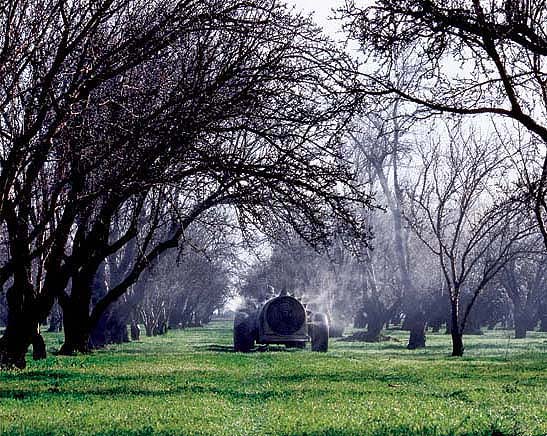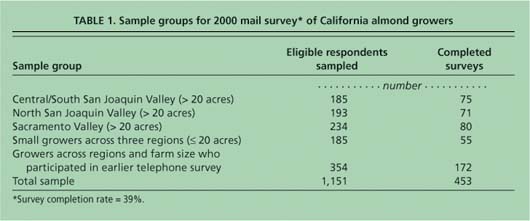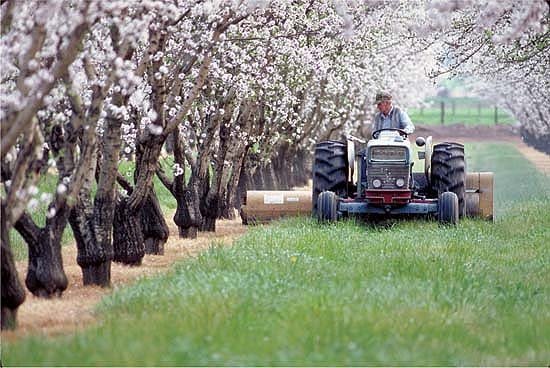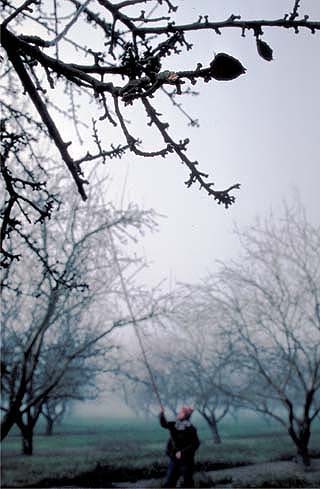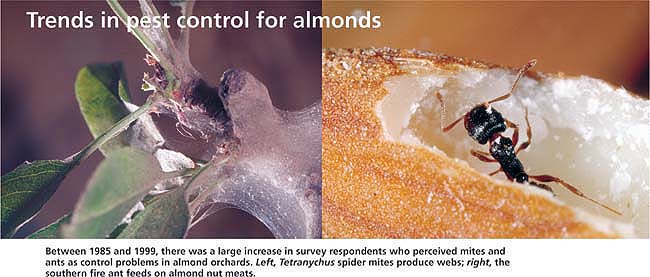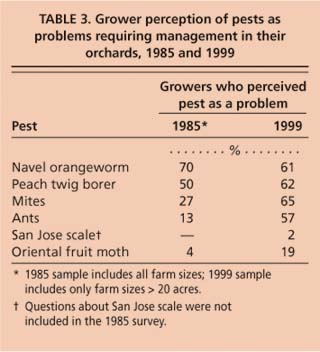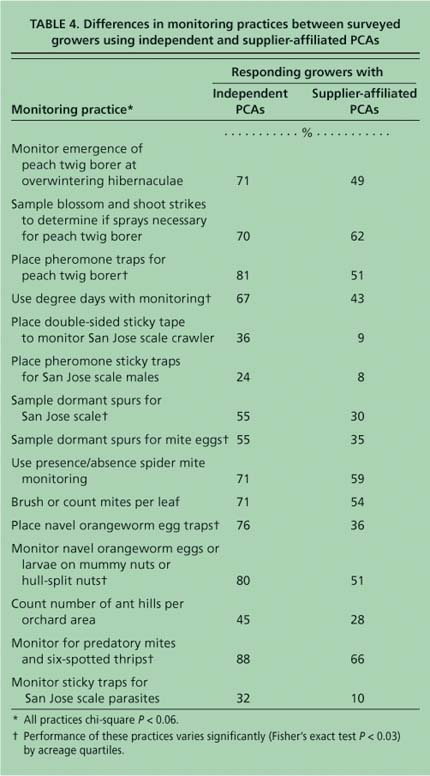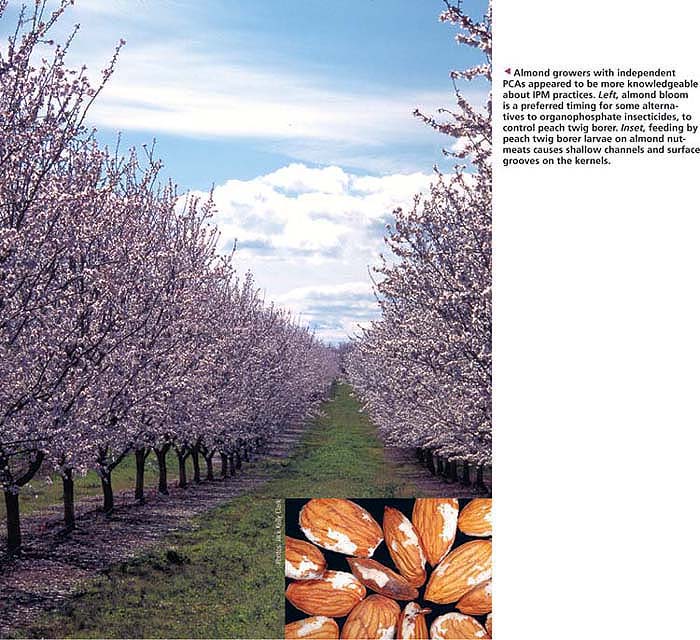All Issues
Almond growers rely on pest control advisers for integrated pest management
Publication Information
California Agriculture 59(4):242-248. https://doi.org/10.3733/ca.v059n04p242
Published October 01, 2005
PDF | Citation | Permissions
Abstract
A comprehensive survey of full-time almond growers in the three primary almond-producing regions of California showed that growers rely substantially on pest control advisers (PCAs) for pest management decision-making. Independent PCAs communicated more frequently with growers than PCAs who are employed by agricultural product suppliers. Growers who use independent PCAs tend to feel more knowledgeable about integrated pest management (IPM) and report the use of more complex pest-monitoring techniques and control practices. The use of insecticide sprays, however, is independent of the type of PCA employed, and the percentage of growers using them has declined substantially since a 1985 survey.
Full text
The goals of the UC Statewide Integrated Pest Management Program include increasing the adoption of integrated pest management (IPM) practices to improve pest control, and reducing growers' need for broad-spectrum pesticides. With more than 6,000 almond farms covering approximately 540,000 acres statewide, almond growers and their consultants are a major focus of UC research and extension (Zalom et al. 2005). The almond industry has worked closely with UC for more than 25 years to implement new IPM practices, most recently utilizing the partnership framework of the Almond Pest Management Alliance (Looker 2005).
DC IPM entomologist and co-author Walt Bentley demonstrates the use of a hand lens to monitor for arthropod pests of almonds. Almonds cover about 540,000 acres in California, making them a significant focus of UC integrated pest management (IPM) outreach and extension. A survey found that pest control advisers (PCAs) also play an important role in providing information to almond growers about IPM.
Many complex factors affect pest management decisions, including the decision-maker's knowledge about and attitudes toward practices that are continually changing. Furthermore, the practices chosen must interact with multiple biophysical and economic variables. In California, state-licensed pest control advisers (PCAs) play a substantial role in helping growers work through these management decisions and are among the most important clientele for UC educational efforts. How these PCAs influence the adoption of IPM practices is a much-debated topic among academics and government agencies.
In particular, some PCAs are affiliated with agricultural product suppliers and so appear to have a conflict of interest. While these supplier-affiliated PCAs provide pest monitoring and consulting services for free, their employers stay in business by selling pest control products. Independent PCAs, on the other hand, are not on the payroll of a supply company and charge a per-acre fee for their services. Whether supplier-affiliated or independent, a PCA's reputation depends on his or her ability to help growers produce quality crops in the most cost-effective manner.
IPM mail survey
In 2000, the UC Statewide IPM Program and the Almond Pest Management Alliance conducted a comprehensive mail survey of almond growers intended to measure their use of specific pest-management practices and to learn more about factors that influence their decisions. We present a portion of the survey results, highlighting declining trends in the use of broadspectrum insecticides, examining how growers' interactions with PCAs may be affecting these trends and exploring the impact of PCA affiliation on the adoption of IPM tactics.
Our sampling was based on the three major almond-production regions in California: the central and southern San Joaquin Valley (Fresno, Kern, Tulare and Madera counties), the northern San Joaquin Valley (Merced, San Joaquin and Stanislaus counties) and the Sacramento Valley (Butte, Glenn and Colusa counties). In order to focus on full-time growers, we sampled those with more than 20 bearing almond acres. Samples were drawn from lists of growers obtained from the agricultural commissioner's offices in eight counties, and from Cooperative Extension mailing lists in the remaining two counties.
The survey included five main sample groups. In each of the three growing regions, we systematically drew approximately equal-sized samples. For each region, we started with a random grower on the list and then drew every nth grower, defining “n” as the total number of growers on the list divided by the final desired sample size. Then, to also include growers with smaller almond farms, we similarly drew a fourth sample from almond growers with 20 or fewer acres across the three regions. Finally, we mailed surveys to a fifth group of almond growers, who were from the same almond-production regions and represented all farm sizes, and had participated in an earlier telephone survey phase of this project (table 1).
The survey was mailed in spring 2000. In order to encourage responses, mailings were personalized as much as possible, used first-class postage and included a postage-paid return envelope, and there were three follow-up mailings. Due to length considerations, half of those surveyed in each sample group received the insect and mite management version of the questionnaire while the other half received the disease and weed management version. Both versions included a set of identical questions pertaining to information sources, attitudes toward IPM and general decision-making factors (including reliance on PCAs for the control of insects/mites, weeds, diseases and nematodes).
A completion rate of 39% resulted in a final response set of 453 growers (table 1). Three hundred and twenty-two of the responding growers had more than 20 acres of bearing almonds in 1999, and 168 of these completed the insect and mite management version of the questionnaire. The results discussed in this article are based either on the larger set of 322 growers with more than 20 acres or on the subset of 168 growers who completed the insect and mite questionnaire.
Air blast sprayers are used for ground applications of pesticides in orchards. Almond growers reported applying dormant season. May and hullsplit insecticide sprays less frequently in the current survey than in a 1985 study.
We used nonparametric statistical tests for two reasons: first, in some instances the groups being compared had different variances; and second, in many cases the variables being tested were categorical (such as yes/no/don't know responses to questions about the use of a practice). We used the Wilcoxon 2-sample test to assess differences in a continuous variable (such as farm acreage) between two groups with unequal variances. Similarly, we used the Kruskal-Wallis test to assess differences in a continuous variable among more than two groups. We used the chi-square statistic to assess differences between two or more groups when categorical variables were involved. Finally, we used Fisher's exact test in cases when sample sizes were too small to allow the appropriate use of chi-square.
Role of PCAs
Grower use of PCAs
Nearly all (97%) of the survey respondents used PCAs for pest management advice, showing that this is a nearly universal practice. About 73% used only one PCA, 21% used two PCAs and 3% used three or more. The degree of PCA influence on decision-making, however, varied with different kinds of pests. For example, 80% of growers reported following their primary PCA's recommendations for insect pest-management actions at least 80% of the time, and 78% of growers followed recommendations for disease management at least 80% of the time. In contrast, only 60% of growers followed their primary PCA's recommendations for weed management at least 80% of the time. Moreover, more than one-quarter (28%) of growers followed their primary PCA's recommendations for weed management only half of the time at most.
These differences in reliance on PCAs are likely due to the fact that for weeds, almond growers tend to follow a set pattern of management practices from year to year. In addition, weeds may not have as direct an impact as other pests on yield and quality, especially in mature orchards. On the other hand, insect/mite and disease management in almonds typically involves more complex monitoring techniques, treatment thresholds (especially for insects and mites) and timings, as well as the consideration of variable weather factors, which facilitates strategic decision-making. Expert input to such decisions can substantially affect pest control efficacy and cost. In addition, insects, mites and diseases directly influence crop quality and tree longevity, and therefore directly affect returns to the grower.
Independent vs. supplier-affiliated
Of all responding growers who used a PCA, nearly two-thirds (64%) worked primarily with a PCA affiliated with an agricultural products supplier, while almost a third (31%) worked primarily with an independent PCA. An additional 5% reported having an in-house or employee PCA.
Statistical tests show that growers with smaller acreage were less likely to use independent PCAs than those with larger acreage. Growers with supplier-affiliated PCAs managed a mean of 233 almond-bearing acres, while those who primarily used independent PCAs managed a mean of 307 almond-bearing acres (Wilcoxon 2-sample, P < 0.001). This difference may be due to the economies of scale afforded to PCAs by larger orchards. The practice of compensating independent PCAs on a per-acre basis provides a disincentive for the PCAs to accept contracts on small farms, where the compensation is smaller relative to fixed costs associated with traveling to and from the orchard regularly.
Fig. 1. Frequencies of (A) orchard inspections, (B) written reports and (C) verbal reports by primary PCA during peak season, as reported by surveyed almond growers.
Strip weed control is used by many almond growers to manage orchard floors. Among the benefits of this approach is reduced pesticide runoff.
TABLE 2. Significance of differences in frequency of PCA orchard inspection and reports for growers with independent versus supplier-affiliated PCAs, by acreage
Growers who reported primarily consulting an independent PCA also had a significantly greater tendency to follow their recommendations for insect/mite and disease management (Wilcoxon 2-sample, P = 0.001 for insect/mite and P = 0.033 for disease) than those who primarily used a supplier-affiliated PCA. The growers with independent PCAs also received more frequent orchard visits (chi-square, P < 0.001) (fig. 1A) and written status reports (figs. 1B and 1C) than growers using supplier-affiliated PCAs. About three-fifths (61%) of the growers employing independent PCAs indicated receiving written reports as often as once per week or more, a significantly higher percentage than the 8% of growers with supplier-affiliated PCAs (chi-square, P < 0.001). Furthermore, most growers (66%) using supplier-affiliated PCAs indicated receiving no written reports at all (fig. 1B). IPM is information intensive, so frequent written reports facilitate the grower's ability to implement least-toxic pest control approaches.
In contrast to independent PCAs, supplier-affiliated PCAs favored verbal reports and most (87%) gave these from once per week to once per month (fig. 1). Even so, significantly more growers with independent PCAs received verbal reports once per week than growers with supplier-affiliated PCAs — more than half versus less than a third (chi-square, P = 0.001). We can only hypothesize the reasons that supplier-affiliated PCAs favor verbal over written reports. Written reports may take longer to complete, and supplier-affiliated PCAs may be more reluctant to take the extra time due to different compensation structures. Verbal interaction with the grower may also allow more opportunities for supplier-affiliated PCAs to promote the company's products.
Acreage
Since growers using independent PCAs also tended to have larger orchards, we performed the above tests on smaller subcategories of growers to determine whether total acreage affected the frequency of PCA orchard visits as well as of verbal and written reports. The four subcategories were selected by taking quartiles of the acreage variable: the first quarter of the sample had 21 to 45 acres, the second had 46 to 96 acres, the third had 97 to 250 acres, and the fourth had 251 to 9,000 acres. In all 12 cases, growers who used independent PCAs tended to report both more inspections and more frequent PCA reports than growers who used supplier-affiliated PCAs (table 2). Six out of the 12 tests resulted in significant P values (P < 0.05), suggesting that farm size may not be a substantial factor in determining the frequency of some PCA activities, while PCA type is an important factor.
The higher frequencies of communication and field visits provided by independent PCAs may be partly responsible for the fact that they reportedly had more influence over grower decisions. Growers may also follow independent PCA recommendations more closely because they pay for them directly. In addition, the reports of PCA activity in this study were based on growers' perceptions rather than empirical measurements. It is possible that growers who pay their PCAs for services also pay more attention to them and therefore are more likely to remember what they did than growers receiving unpaid services from supplier-affiliated PCAs.
Trends in pest control practices
Pesticide use
In debates about the significance of PCA affiliation, an issue that is often raised is whether supplier-affiliated PCAs promote more chemical use. It is often assumed that independent PCAs are more likely than supplier-affiliated PCAs to recommend fewer sprays and to promote IPM. We tested this assumption by examining growers' responses about applying insecticides during the three most common insecticide-treatment timings for almonds: the dormant season, in December and January for almond growers; in May, when susceptible stages of navel orangeworm, peach twig borer, oriental fruit moth and San Jose scale may be present; or at hull-split, which typically occurs in early July.
Winter mummy-nut removal is critical to managing navel orangeworm. Growers with independent (non-supplier-affiliated) PCAs were more likely to perform winter-sanitation measures such as poling (shown), which helps to prevent overwintering of the pest's larvae.
Two-thirds (66%) of responding growers reported spraying insecticides during the 1998 to 1999 dormant season (n = 154), about one-fifth (22%) applied a May spray (n = 156), and more than half (59%) applied a hull-split spray (n = 158); for each practice, the percentage who answered “don't know” was less than 2%.
We found that the affiliation of PCAs did not have a significant effect on responding almond growers' use of common chemical controls for insect and mite pests. Whether or not they used an independent or supplier-affiliated PCA, growers were statistically as likely to use insecticide sprays during the 1998 to 1999 dormant season (62% and 70%, respectively, chi-square, NS), in May (19% and 27%, chi-square, NS) and at hullsplit (56% and 65%, chi-square, NS) to control peach twig borer, San Jose scale or navel orangeworm.
Trends in pest control for almonds
Between 1985 and 1999, there was a large increase in survey respondents who perceived mites and ants as control problems in almond orchards. Left, Tetranychus spider mites produce webs; right, the southern fire ant feeds on almond nut meats.
California's almond IPM program was chosen as a case study for the 1985 USDA National Evaluation of Extension IPM Programs (Klonsky et al. 1990). The 1985 mail survey was conducted by UC Davis agricultural economist Karen Klonsky and UC IPM director Frank Zalom in collaboration with the Almond Board of California, which provided mailing lists of growers affiliated with both the Blue Diamond Growers Cooperative and independent handlers from which names of growers were drawn at random.
Although less comprehensive than the 1999 survey, several questions — including the perceived importance of different pests, use of various IPM practices, and use of specific seasonal spray timings — were asked in both surveys. Comparing the 1999 mail survey of IPM use with the 1985 survey shows that almond growers continue to perceive the navel or-angeworm and peach twig borer to be key insect pest problems, while the relative importance of mites and ants increased during this time (table 3). The navel orangeworm is a target of two spray timings (May and hull-split), while the peach twig borer is a target of all three spray timings (dormant season, May and hull-split).
Despite the continuing importance of key insect-pest problems in growers' perceptions, the reported use of insecticide sprays declined substantially during all three timings. From 1985 to 1999, May sprays declined from 78% to 22%, dormant-season sprays declined from 93% to 61%, and hull-split sprays declined from 82% to 59%. The reduction in dormant sprays — especially or-ganophosphates — during the 1990s has been documented by other researchers analyzing pesticide-use reports submitted by almond growers statewide, as required by the California Department of Pesticide Regulation (Epstein and Bassein 2003; Zhang et al. 2004).
The decline in use of dormant and in-season sprays reflects to some extent the history of UC's almond pest management guidelines. In the 1970s and 1980s, UC guidelines preferred the use of dormant-season insecticide sprays to control peach twig borer, San Jose scale and the eggs of both brown almond mite and European red mite. Spraying during the dormant season reduces overwintering populations of these pests while minimizing insecticide exposure of biological control agents, nontarget organisms, and workers in orchards during the growing season.
TABLE 3. Grower perception of pests as problems requiring management in their orchards, 1985 and 1999
During the 1990s, however, the UC guidelines were revised to reflect the availability of new commercial products that control target pest species, new research findings on alternative pest-control practices and increasing environmental concerns. The new UC guidelines more strongly emphasize monitoring for the appropriate pests before applying sprays during any of the three timings, and also suggest alternative controls and treatment timings (Zalom et al. 2005). For example, monitoring for peach twig borer and navel orangeworm was recommended as a prerequisite to using in-season sprays, and the May spray was only suggested if warranted by monitoring and if a dormant spray and winter mummy-nut removal had not been performed.
There was also no difference in the use of two IPM practices without insecticides, dormant oil (33% and 27% respectively, chi-square, NS) and summer oil alone without insecticides (16% and 10%, chi-square, NS) to control scale, spider mites or leafhoppers. The reported use of biopesticides—those toxins derived from microbial or botanical sources, such as Bacillus thuringiensis (Bt) and spinosad—was also similar by growers using either independent or supplier-affiliated PCAs (50% and 46%, respectively, chi-square, NS). “Don't know” responses for all of these practices were 7% or fewer.
Grower knowledge
Almond growers using independent PCAs reported feeling more knowledgeable about IPM than those using supplier-affiliated PCAs (chi-square, P = 0.009). While the majority of growers in both groups reported feeling either somewhat or moderately knowledgeable about IPM (74% of those with independent PCAs and 83% of those with supplier-affiliated PCAs), considerably more growers with independent PCAs reported feeling very knowledgeable than did those with supplier-affiliated PCAs (19% versus 5%, respectively). It is possible, however, that almond acreage influences these results. We conducted the same statistical tests for differences within the four subcategories of growers as defined by acreage quartiles, and the results were nonsignificant in all four cases (P > 0.05).
In any case, even a discernible difference between growers using different types of PCAs does not mean that consulting with independent PCAs is in itself responsible for growers' greater confidence in their IPM knowledge. Rather, such results may only indicate that growers who are more knowledgeable and perhaps more interested in IPM also have a higher tendency to use independent PCAs. On the other hand, half of the surveyed growers with independent PCAs reported that they first heard about IPM from a private consultant or PCA, as opposed to only a fifth of the growers with supplier-affiliated PCAs. These results suggest that independent PCAs might be somewhat more likely to introduce growers to IPM.
Use of IPM
Growers using different types of PCAs varied significantly in the use of several cultural controls and monitoring techniques (chi-square, P < 0.05). For example, responding growers with independent PCAs were more likely than growers with supplier-affiliated PCAs (90% versus 65%, respectively) to perform winter sanitation by knocking mummies from trees by hand with poles or by shaking mummy nuts—the overwintering site of navel orangeworm larvae—from the trees with mechanical shakers. Winter sanitation is one of the most important means for controlling navel orangeworm and can reduce the need to apply insecticide sprays during spring and summer. Similarly, growers with independent PCAs were more likely to determine the effectiveness of sanitation by counting mummy nuts than growers using supplieraffiliated PCAs (78% versus 40%, respectively). However, both winter sanitation and counting mummy nuts also varied significantly by acreage (chi-square, P < 0.001 and P = 0.032). Growers with larger acreage were more likely to perform winter sanitation and count mummies than those with smaller acreage, suggesting that the role of farm size should be examined more critically.
Almond growers with independent and supplier-affiliated PCAs also reported significant differences in the use of IPM monitoring practices (chi-square, P <0.06) (table 4). Notably, growers with independent PCAs were also more likely to respond “don't know” to monitoring questions than growers with supplier-affiliated PCAs (“don't know” responses ranged from 5% to 24% for the former, compared to 1% to 14% for the latter), suggesting that growers using independent PCAs rely more heavily on them to carry out monitoring activities and that the growers may not understand the PCA's specific methodology.
TABLE 4. Differences in monitoring practices between surveyed growers using independent and supplier-affiliated PCAs
Linking growers to IPM extension
This survey shows that PCAs are important to almond growers as sources of information on IPM practices, especially for insect and mite pests and diseases. Furthermore, some of the findings suggest that greater contact between growers and PCAs, in person and through written reports, might help growers become better informed about IPM practices in general and more specifically about pest problems on their own farms.
Our study found a high degree of self-reported grower reliance on PCAs for assistance in pest management decision-making, supporting the assertion that PCAs can make a substantial difference in grower understanding and approaches to pest management. Moreover, the influence of PCA affiliation on grower knowledge and the use of different practices should be reconsidered and studied further. While our study does not support the notion that supplier-affiliated PCAs encourage more chemical insecticide use, it does point toward possible increases in knowledge and use of IPM practices by growers employing independent PCAs. However, this study does not show whether this association occurs due to PCA influence on growers or because growers who hire independent PCAs are already predisposed toward IPM.
Almond growers with independent PCAs appeared to be more knowledgeable about IPM practices. Left, almond bloom is a preferred timing for some alternatives to organophosphate insecticides, to control peach twig borer. Inset, feeding by peach twig borer larvae on almond nutmeats causes shallow channels and surface grooves on the kernels.




